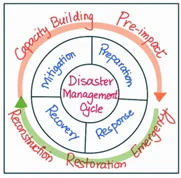Answer:
| Approach:
Introduction
- Brief about transitioning India’s disaster Management.
Body
- Discuss about the Recent Initiatives in Disaster Management.
Conclusion
- Conclude your answer with a comprehensive Approach.
|
Introduction:
Disaster management in India has traditionally been reactive, with the focus on response and relief operations after a disaster has occurred. The Government of India has taken several measures to shift the focus towards a more proactive approach to disaster management.

Body:
Recent Initiatives in Disaster Management:
- National Disaster Management Plan: The Government of India has developed a comprehensive National Disaster Management Plan that outlines the roles and responsibilities of various stakeholders in disaster management.
- Enhancing Emergency Preparedness: The 2nd BIMSTEC Disaster Management Exercise focuses on flood rescue operations. Held at Ramachandi Beach in Puri, this field training exercise aims to bolster regional response mechanisms and ensure effective disaster management in the BIMSTEC region.
- The plan emphasizes a proactive approach to disaster management and focuses on building resilience and reducing the risks associated with disasters.
- Building a Safer Future: Empowering member nations with technical aid, capacity building, research, knowledge management, and advocacy, the CDRI is dedicated to facilitating investments in robust infrastructure systems that can withstand and mitigate the impact of disasters worldwide.
- National Disaster Response Force (NDRF): The NDRF is a specialized force created by the Government of India to respond to disasters. The force is equipped with specialized equipment and trained personnel to respond to disasters effectively. The NDRF has been expanded and strengthened in recent years to improve its response capabilities.
- Indian Coast Guard’s: Tntervention averts fatalities and minimizes damage caused by Cyclones Amphan and Nisarga. Employing ICG Remote Operating Centers and Stations, NAVTEX warning system, and International Safety Net, they activate Maritime Rescue Coordination Centers one week ahead, ensuring preparedness and effective response.
- Disaster Risk Reduction: The Government of India has emphasized the importance of disaster risk reduction in recent years.
- The focus is on building resilience and reducing the risks associated with disasters through measures such as land-use planning, early warning systems, and public awareness campaigns.
- Technology-Enabled Disaster Management: The Government of India has leveraged technology to improve disaster management in the country.
- Initiatives such as the National Disaster Management Information System (NDMIS) and the use of satellite imagery for disaster response have been introduced to improve the response capabilities of the authorities.
Conclusion:
The Government of India has initiated several measures to improve disaster management, departing from the earlier reactive approach. The emphasis on preparedness, risk reduction, and community involvement has the potential to enhance India’s disaster resilience and reduce the impact of disasters. It is crucial to continue strengthening these measures to ensure effective disaster management in the future.
